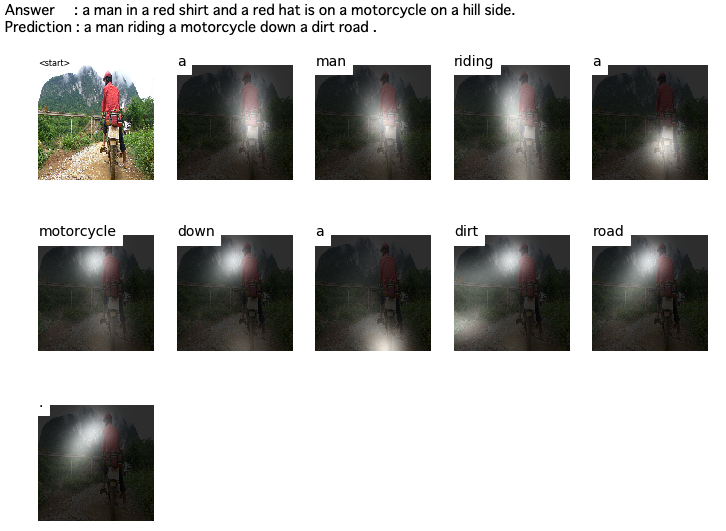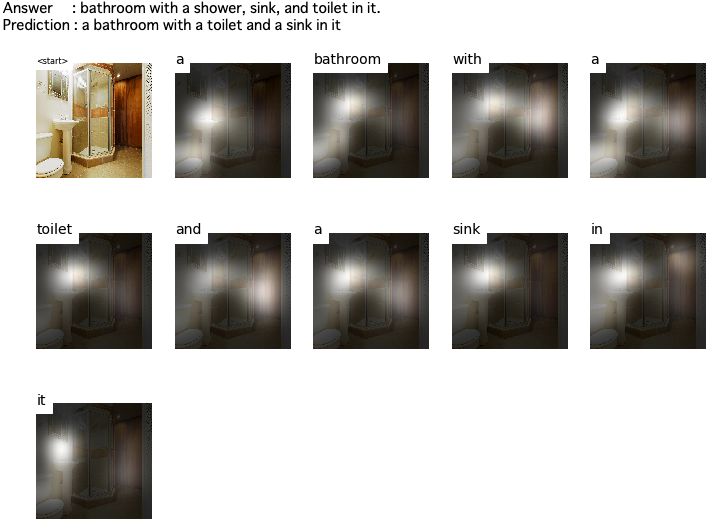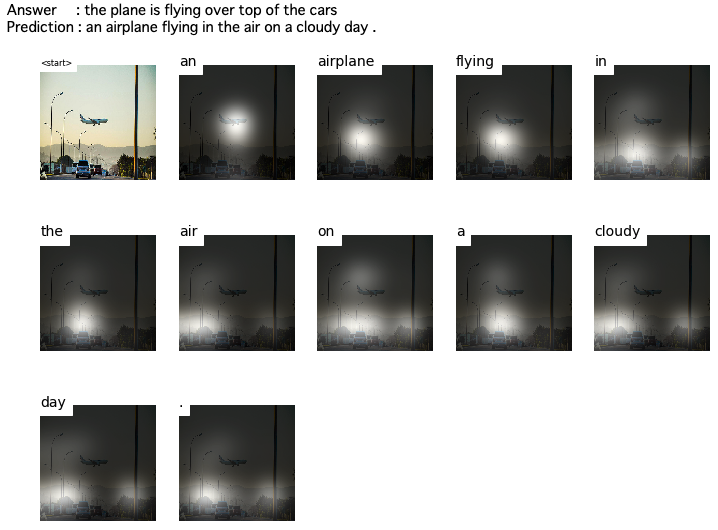This repository reimplement "Show, Attend and Tell" model.
paper: Show, Attend and Tell: Neural Image Caption Generation with Visual Attention (https://arxiv.org/pdf/1502.03044.pdf)
Adittions:
- Clip Gradient
- Beam Search
First ensure that you have installed the following required packages.
pip install -r requirements.txt
- python 3.5.2
- numPy 1.13.1
- pandas 0.23.0
- matplotlib 2.0.2
- pillow 5.1.0
- PyTorch 0.4.1
- tqdm 4.24.0
- Natural Language Toolkit (NLTK) 3.2.4
If you need weights of trained model, please download below shared URL. The data size is about 320.5 MB. https://drive.google.com/drive/folders/17HZVCFdVjoEz0yG-hZF929Ra8CtT2yM2?usp=sharing
MS-COCO dataset downloaded in following path. Image format is ".jpg".
Image Path:
show_attend_and_tell/data/images/train_2014 or val_2014/
Caption (Answer label):
show_attend_and_tell/data/annotations/captions_train2014.json
If downloading by yourself, both training and validation are necessary.
Downloding from here (http://cocodataset.org/#download).
Train data:
wget http://images.cocodataset.org/zips/train2014.zip
Validataion data:
wget http://images.cocodataset.org/zips/val2014.zip
Caption data:
wget http://images.cocodataset.org/annotations/annotations_trainval2014.zip
Build datasets with columns of image paths and corresponding captions.
Each datasets are saved in csv format under the directory of "../data/label/"
# build train and validation datasets
python3 ./src/build_dataset.py
Based on the frequency of words appearing in training data, build vocaburary to use model. default vacaburary size is 10,000.
The vocaburary is saved in "../data/vocab/vocab.pkl".
# build vocaburary
python3 ./src/build_vocab.py
In training, encoder and decoder are learned at the save time based on cross entropy loss of caption and loss of attention mechanism.
1. ./src/train.py [-h] [--root_img_dirc] [--train_data_path]
[--vak_data_path] [--vaocb_path] [--save_encoder_path]
[--save_decoder_path] [--fine_tune_encoder] [--resize] [--crop_size] [--shuffle] [--num_workers]
[--vis_dim] [--vis_num] [--embed_dim] [--hidden_dim]
[--alpha_c] [--vocab_size] [--num_layers] [--dropout_rate]
[--encoder_lr] [--decoder_lr] [--num_epochs] [--min_epoch]]
[--batch_size] [--stop_count] [--grad_clip] [--beam_size]
Hyper parameters and learning conditions can be set using arguments. Details are as follows.
[--root_img_dirc] : The directory of raw image
[--train_data_path] : The path of training dataset
[--val_data_path] : The path of validataion dataset
[--vocab_path] : The path of vocabuary
[--save_encoder_path] : The path of save the weight of trained encoder
[--save_decoder_path] : The path of save the weight of treined decoder
[--fine_tune_encoder] : Fine tuning encoder model (True or False)
[--resize] : Size for resizing the image before random crop (tuple)
[--crop_size] : Image size to be input to encoder (tuple)
[--shuffle] : Whether to shuffle the dataset at training
[--num_workers] : The number of threads used during training
[--vis_dim] : The number of input dimensions of decoder
[--vis_num] : The numebr of input channel of decoder
[--embed_dim] : The dimension of emnedding
[--hidden_dim] : The number of dimension of hidden layer of LSTM
[--alpha_c] : The ratio of attention mechanism on loss
[--vocab_size] : The number of vocabulay to use
[--num_layers] : The number of LSTM layer
[--dropout_rate] : Dropout rate of decoder
[--encoder_lr] : The learning rate of encoder
[--decoder_lr] : The learing rate of decoder
[--num_epochs] : The maximum number of epoch
[--min_epoch] : The minimum number of epoch
[--batch_size] : Bach size
[--stop_count] : If not_improved_count < stop_count, execute early stopping
[--grad_clip] : To set the threshold of the gradient
[--beam_size] : Search width of beam search
Evaluate the test data with BLEU score using the trained model. The procedure is as follows.
# Set path of trained model and path of test data.
# output is 2 columns csv file. (col1, col2) = ("pred", "ans")
1. ./src/prediction.py [-h] [--root_img_dirc] [--test_data_path]
[--vocab_path] [--encoder_model_path] [--decoder_model_path] [--save_dirc]
[--vis_dim] [--vis_num] [--embed_dim]
[--hidden_dim] [--vocab_size] [--num_layers] [--dropout_ratio] [--beam_size]
# If you want to see the result visually, please use jupyter notebook
2. ./src/visualize.ipynb
# Evaluate using the csv file calculated by the above procedure.
# The metrics is BLEU 1-4
3. ./src/bleu.py
Hyper parameters of prediction model can be set using arguments. Details are as follows.
[--root_img_dirc] : The directory of raw image
[--test_data_path] : The path of test dataset
[--vocab_path] : The path of vocabuary
[--encoder_model_path] : The path of trained encoder model
[--decoder_model_path] : The path of treined decoder
[--save_dirc] : The path of save the prediction result
[--vis_dim] : The number of input dimensions of decoder (the same number as training)
[--vis_num] : The numebr of input channel of decoder (the same number as training)
[--embed_dim] : The dimension of emnedding (the same number as training)
[--hidden_dim] : The number of dimension of hidden layer of LSTM (the same number as training)
[--vocab_size] : The number of vocabulay to use (the same number as training)
[--num_layers] : The number of LSTM layer (the same number as training)
[--dropout_rate] : Not use dropout (set 0.0)
[--beam_size] : Search width of beam search



